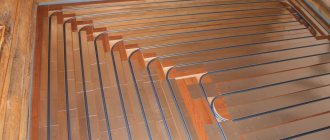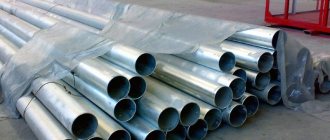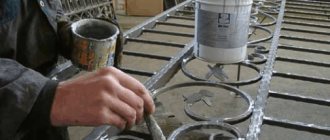Transport is one of the “pillars” on which the economy stands. It provides connections between enterprises, industrial, trade, agricultural and supply facilities. The development of any city, region and country directly depends on the development of the transport system, in which roads occupy first place. Depending on the characteristics of road operation, they are classified into several types. The construction of each is carried out strictly according to technology regulated by specialized bodies. In this article we will take a detailed look at the classification of road surfaces.
Classification of road surfaces
Transport is one of the pillars on which the economy stands. It provides connections between enterprises, industrial, trade, agricultural and supply facilities. The development of any city, region and country directly depends on the development of the transport system, in which roads occupy first place. Depending on the characteristics of road operation, they are classified into several types. The construction of each is carried out strictly according to technology regulated by specialized bodies. In this article we will take a detailed look at the classification of road surfaces.
Coating technology
For many years now, the coating technology has not changed. After preparing the base, regardless of the purpose of the future road network, the so-called finishing is carried out.
Read on topic: Removing snow from roads
The final finish is a “black” base, the main purpose of which is to equalize operational loads. A special mineral material with high strength properties, which is specially treated with a binder, is widely used.
Asphalt concrete consists of: crushed stone, sand, mineral additives (enveloped in bitumen) and binder (high molecular weight organic compound). For laying, asphalt concrete mixtures with a wide temperature range are used - from hot to cold cycles. The laying process is carried out using the “tracking” system (laser) of the auto-stacker. ABS is laid on a surface previously primed with emulsion, after which it is thoroughly compacted.
General road structure and classification of road surfaces
Any road consists of two layers:
- Travel clothing.
- Subgrade.
Road “clothing”, in turn, consists of two more components:
The coating is highly durable and wear-resistant. This is the “upper” part of the road that takes the impacts of car wheels and weather conditions. The coating must be durable, moisture-resistant, stable and rough in order to ensure the necessary grip of the wheels on the road. Otherwise, the number of accidents in such areas will simply go through the roof. The coating also consists of two more layers:
- Bearing layer.
- Wear layer.
The base is the load-bearing part of the road, which consists of multi-layered soil or stone materials specially treated with binders. Any road in cross section resembles a piece of “Napoleon” with “cakes” of different density and thickness.
Tip: Road pavement is the focus of road construction. The share of its cost in total construction costs usually exceeds 50%. That is why the emphasis is on the quality of clothing. The higher the category of the road, the more reliable and durable this layer will be.
Top layers of asphalt concrete
Road pavement includes several layers of asphalt concrete of varying densities. First of all, a more porous asphalt mixture is laid, and then a less porous and more durable one, designed to resist wear, as well as increase the surface roughness to ensure traction of car wheels with the road.
Also, the dense top layer of asphalt prevents moisture from entering the inner layers of the roadway, which increases the service life of the structure. If water gets into the inner layers of the coating, when it freezes, expansion will occur, which can destroy the coating from the inside. This is especially true for our country, since throughout the year there are repeated temperature changes from plus to minus, and vice versa.
The main types of asphalt concrete by composition:
- Sandy;
- Gravel;
- Crushed stone-mastic.
Sandy asphalt
has the lowest performance characteristics from this list, therefore it is suitable for installing only those types of coating that will not be subject to serious external influences. These could be pedestrian areas or some private areas.
Gravel asphalt
has higher physical and mechanical characteristics, and can be used to pave high-category roads. However, at present, this type of asphalt concrete has been almost completely replaced by crushed stone-mastic mixtures.
Crushed stone mastic asphalt (SCMA)
is the leader of this list in terms of its performance characteristics. Can be used, among other things, for category I roads with increased traffic load. Hard rocks in the composition of SMA form a strong coating frame, and the addition of special cellulose fibers prevents the spreading of the bitumen binder.
note
. The cost of laying asphalt will vary depending on the material, as more durable asphalt concrete costs more. However, due to its high physical and mechanical characteristics and long service life, the use of high-quality asphalt is more than justified.
The main types of asphalt concrete according to laying technology:
- Hot;
- Cold;
- Cast.
| Material | Description |
| Hot asphalt | Hot asphalt has high performance characteristics, so road pavement using this asphalt concrete can be used for the construction of roads of any category. When laying, the mixture must be heated to 110-130°C, and the air temperature must be at least +5°C. |
| Cold asphalt | Cold asphalt has lower physical and mechanical characteristics and is therefore not suitable for pavement on busy roads. However, the advantage of cold asphalt is different - strength gains occur due to the evaporation of hydrocarbon compounds. Thanks to this, this material does not need to be heated before installation, and work can be carried out even in cold seasons. Most often, cold mixtures are used for pothole repair, which is especially important when the coating needs to be brought back to normal as soon as possible. |
| Cast asphalt | Cast asphalt can be classified as a hot mix, since it is heated to 190-250°C before laying. Like hot cast asphalt concrete, it has high performance characteristics and can be laid at air temperatures from +5°C. The main feature of cast mixtures is that there is no need for compaction after installation. This material has a liquid consistency, and the increase in strength during the cooling process ensures a residual porosity within 2%. Can be used for roads of any category. |
Rigid and non-rigid coatings
Flexible roads can be “sorted” by type:
- Ground. Used for paths in parks and gardens. They perform a purely decorative function. They require virtually no investment to create.
- Crushed stone. Not designed for high loads. They are actively used in remote corners of rural areas where there are no opportunities for an asphalt alternative.
- Gravel. Almost identical to crushed stone. They differ only in the base material. The purpose of use and general characteristics are almost similar to crushed stone.
Hard ones, in turn, can be divided into several subgroups:
- Asphalt. Currently the most common type of road surface. This popularity is justified by a good combination of the price of materials and the quality of the finished fabric.
- Paved. Gradually they became a thing of the past. The construction is based on the laying of natural stone, which causes the overall high cost of the entire process. Used exclusively for decorative purposes.
- Prefabricated cement structures. They are distinguished by increased stability and the ability to withstand enormous loads. They are used in the construction of bridges, which provides them with additional stability.
Advice: each of the above types can only be used in strictly defined situations for certain types of transport. Rigid road surfaces are considered a couple of degrees higher than non-rigid ones. They are stronger, but during construction they also require significantly higher financial costs for materials and labor.
Coating components
The quality of the final coating depends on many factors. One of them is a natural substrate. More precisely, we are talking about the soil that will be under the road surface. This is the first layer. In some areas, there may be a strong displacement of the surface soil, so it is necessary to go deeper to a certain level, which is more stable, and also to make a larger layer of embankment. An important point when laying a roadway is to provide drainage. They promptly drain away rain and other water, which, if retained, can lead to the destruction of the road surface. This especially happens during the cold season, when the liquid, freezing in the pores, expands and leads to deformation of the asphalt.
The width of the roadway includes not only the roadway. Material consumption also includes the roadsides where cars are parked. High-quality road clothing consists of several types of layers. It is designed to last a long time. This type of road surface is expensive to produce, but less expensive to maintain since it has a long service life. If repair work is carried out in a timely manner, only the top layer is subject to wear. The bottom layer of the road surface, which serves as the base and provides load-bearing properties, must remain undamaged, since a significant part will have to be resurfaced to repair it. Below the load-bearing covering is the base. In road pavements, it ensures uniform distribution of loads on the substrate or soil, which eliminates pushing under the heavy weight of trucks.
In areas where the temperature drops far below zero in winter, there is an additional layer to the base. Its task is to transfer the load and distribute it along the ground, as well as to ensure the resistance of all road pavement to the destructive effects of frost. In areas where significant precipitation is observed and water may be retained, there is a drainage layer that promptly removes moisture from the canvas. For these purposes, the following can be laid: coarse sand, crushed stone, soil, which is additionally treated with additives that improve its stability, crushed rock. Where the listed options are not available, local building materials are used.
Afterword
When choosing the type of future road, experts always start from a combination of factors, the main one of which is considered to be the intensity of traffic on the site. The higher it is, the higher the wear of the road surface will be. Accordingly, in areas of constant use, roads are built more durable. For more “quiet” areas, a lightweight version is used, which, if necessary, can be reclassified as a transitional one if an increase in load is planned in the future.
Hard surfaces prevail in densely populated areas with well-developed infrastructure. They are much inferior to non-rigid roads in rural areas, where only central streets or roads leading to large agricultural facilities can usually boast of a hard surface.
What structural layers and materials does the road surface include?
| Road construction area | What is used in the design |
| Soil foundation |
|
| Travel pillow |
|
| Asphalt concrete pavement |
|
Categories of roads. Classification and purpose of roads
Road communication is the most important part of the economy of any country, because it plays an important role in the level of development of industry and production of the state. And Russian roads are no exception in this regard. In order to determine the level of quality and traffic flow, a list of specific requirements for roads has been developed. Those of them that fully meet the presented criteria are capable of accepting transport flows of any complexity and completeness and facilitating the delivery of passengers and cargo in all directions and over any distance. That is why it is worth paying close attention to the question of exactly what categories of highways exist and how they are classified.
How everything works
To increase traffic safety and improve cross-country ability, a modern highway is developed as a complex technical structure and is built on a specially designated area of terrain called a right-of-way. There the roadway itself is constructed, along which vehicles move. To ensure increased throughput, driving comfort and traffic safety, almost all types of roads are equipped with hard surfaces: asphalt, concrete and other construction materials. The width of the carriageway for a single-lane road is at least 7 meters. A small part of the right-of-way does not have a hard surface and is not included in the road surface - it is used as additional area. Detour roads and bicycle paths are laid here, and this part of the road is also allocated for the movement of tractors and horse-drawn vehicles. Additionally, in this part of the right-of-way, drainage and forest protection structures are installed, and when repairing the road surface, construction materials are immediately stored.
Sand bedding
Sand backfill is used for almost all known types of foundations and serves to maintain a sufficient level of drainage.
Read on topic: Road drainage
Sand serves to maintain good shock absorption and drainage of the road surface, and therefore road builders are very careful in choosing it. River sand is often used, with grains of 1.7 -2.3 mm, which is considered medium in size. Great importance is also paid to the purity of the material, i.e. clay impurities are excluded to the maximum. The sand cushion is carefully compacted and a geofabric is laid, which will separate it from a layer of crushed stone and gravel.
Keep in mind that the use of even small admixtures of clay will negatively affect the operation of the entire sand cushion. Since clay properties are absolutely opposite to sand. As a result, there will be slight or even severe swamping and flooding of the road section, not only after precipitation, but also in the spring-autumn period.
Different categories
Categories of highways in different countries of the world have various evaluation criteria, however, by generalizing them a little, we can make approximately the following list:
- E – overpasses of European significance;
- M – routes of federal significance;
- R – roads connecting administrative centers;
- A – federal and regional roads, approaches to the largest transport hubs - airports, sea and river ports;
- K – regional roads;
- N – other local roads.
There are also several other criteria by which roads for different purposes can be classified:
- by coverage width and number of lanes;
- according to the principle and method of crossing with different types of roads;
- by the presence or absence of markings and dividing strips.
It is the last dividing principle that says whether the road is operational, whether it intersects with other roads and how many times, how traffic is regulated, how many turns there are and other parameters.
General information about roads
Categories:
- E – European roads.
- M – federal highways.
- R – roads between administrative centers.
- A – roads leading to transport hubs: airport, river port, seaport, etc.
- K – roads in the regions.
- N – other roads.
Most often, all roads are divided into three types: highway, expressway and regular road.
Expensive ones are also divided into classes:
- Expressways (highway, freeway, etc.) - the width of such a road must be at least 15 m. There must also be a dividing strip. More than two lanes in one direction. Such roads are designed for large traffic flows. Such roads must be covered with high-quality concrete. On roads of this type, driving speeds of more than 120 km/h are allowed. Statistics show that more than 7,000 cars pass on such highways within 24 hours.
- Asphalt roads are most often roads that connect administrative centers. The width of the road in this case should be more than 7.5 m. During the day, the traffic flow reaches 3-3.5 thousand cars. Permissible speed up to 120 km/h.
- Highways with lower capacity - usually less than 3,000 cars. The width of such roads according to standards is 3.5 -7 m. The surface can be asphalt, but sometimes just a cobblestone surface is allowed. The speed limit on such roads reaches 100 km/h, and vehicles over 6 tons cannot pass. This category has lower quality coverage. That is why traffic is difficult, especially in autumn and spring. The speed should not exceed 80 km/h, and only 1000 cars pass per day. Trucks are not allowed on this road as they can cause serious damage to the surface.
- Country road - in most cases this road is not covered at all.
- Forest road - from the name it is clear that these are roads that run through the forest. These roads are most often used to monitor the condition of the forest; rangers, timber trucks, etc. move along them. Firefighters also move along these roads in the event of a forest fire.
Unfortunately, not all roads in Russia can boast of good quality. But this is precisely what cargo and passenger transportation depend on. Poor quality roads can lead to accidents, vehicle breakdown, increased fuel consumption, etc.
Depending on the surface, roads are divided into:
- pavements,- - roads made of cement and concrete,
- - gravel,
- - ground,
- - tar concrete,
- - roads made of asphalt and concrete,
- - coating with organic materials.
Principles of classification
Basically, all roads are classified primarily based on the principle of how traffic is carried out and how easy access is provided to them. If we consider the categories of roads from this position, we can distinguish 3 main classes:
- motorway;
- expressway;
- ordinary road.
Each of them has its own subclasses, that is, it is divided into types depending on the geographical location:
- regional;
- regional;
- territorial;
- regional;
- national;
- international traffic;
Of course, such a division is rather arbitrary, but in practice everything is somewhat more complicated. The fact is that each country adopts its own categories and signs of division - in Russia, for example, there are five categories of roads, and in Ukraine there are only four.
Construction of road pavements from gravel and crushed stone materials
Gravel and crushed stone roads guarantee year-round use, as well as the ability to carry out construction work in all weather conditions.
Such pavement is laid on a previously prepared section of soil, if the cohesive earth cover is constructed with a crescent-shaped profile. On soils with a high drainage system, it is recommended to install a semi-open profile.
But the most common are roads with a completely filled base, that is, first a sand cushion is prepared above the ground level, then the side of the road is added, thereby forming a so-called trough profile. This type of construction is most optimal in the absence of building materials.
Gravel and crushed stone roads are poured in one layer if the thickness is no more than 20 cm. If the height of the clothes is more than 20 cm, then two layers are arranged, with each one carefully compacted.
First category
The first category of roads in Russia includes motorways, expressways and highways. Such overpasses have a width of at least 15 meters and are equipped with a dividing strip. There are at least two lanes in each direction, at least 3.75 meters wide. Such roads are designed for high traffic volumes and are equipped with high-quality concrete pavement that can withstand a large influx of vehicles. The capacity of such overpasses exceeds 7,000 cars per day, while vehicles move at a speed of at least 120 km/h.
Ground or subgrade
Before construction of a road begins, the soil base must be properly prepared. Due to this, all road pavement will have higher characteristics, as a result of which the service life of the road as a whole and each structural layer separately will increase.
Once a pit has been dug to the required depth, the subgrade is cleared and compacted to begin construction. Also at this stage, the construction of a drainage system is taking place, which will effectively drain water to the side and roads.
Fourth and fifth categories of roads
The fourth category of roads is characterized by the presence of a coating of rather low quality. Because of this, movement along them can be very difficult, especially in the autumn-spring period. Such tracks can carry no more than 1,000 vehicles per day, and the speed along them is limited to 80 km/h. For heavy vehicles, passage on such roads is most often completely closed, due to the fact that the movement of heavy vehicles leads to rapid and serious destruction of the road surface.
Road paving
All city dwellers, and not only city dwellers, are familiar with asphalt road surfaces.
In the construction stages of country villages, asphalting roads belongs to the improvement stage. Despite its strength, asphalt is not able to withstand heavy construction equipment and during the main construction stage, roads are left either unpaved or covered with crushed stone.
Asphalting roads is the final road finishing. Asphalting is carried out on a solid base with an underlying regulatory layer. The asphalt is laid hot from two to five layers.
Before asphalting, all road and near-road work is carried out on drainage, arrangement of exits to sites, installation of cable and/or overhead lines for street lighting, and most importantly, obtaining permission and arrangement of exits from the federal highway.
Forest roads - classification
A separate type of classification can be called the purpose of roads. Forest roads are a separate type of roads in Russia. As is clear from the name, they are located in forested areas and serve for hassle-free transport access to these parts of Russia.
- forestry - designed to monitor the condition of forest areas, it is along them that rangers walk around the territories entrusted to them;
- timber carriers - provide transport links when felling timber for industrial and sanitary purposes; since heavy freight vehicles move along them, they are additionally strengthened to ensure increased cross-country ability for heavy vehicles;
- fire protection - designed to provide fire crews with access to potential fires;
In earlier times, one more type of road could have been added to this list - a flat road, but now they are practically not built, and the old ones have long since fallen into disrepair. The fact is that the road surface in this case is a deck made of solid logs. It is possible to build such a road quickly, but it is impractical - after all, wood is not cheap these days, and a lot of it will be spent on such a road. And the service life of such a coating compared, for example, with asphalt, is short; the wood quickly rots and deteriorates in unfavorable weather conditions.
In what order is the roadway constructed?
Key stages of road construction:
- 1. Soil preparation: 1.1. Removing the top layer;
- 1.2.Cleaning the area from debris, dirt, plants, etc.;
- 1.3. Leveling the subgrade;
- 1.4. Backfilling (if necessary);
- 1.5. Dust removal and drying (if necessary);
- 1.6.Drainage device;
- 1.7. Compaction of the earthen base.
- 2.1.Laying geotextiles;
- 3.1.First of all, the coarse-grained mixture is laid and compacted;
When multi-layer asphalt paving requires compacting each layer separately.
immediately after installation - this will ensure high density, which will increase strength and improve waterproofing. The more the roadway is loaded, the more layers of asphalt concrete need to be laid. In some cases, the thickness of the asphalt coating reaches 30-40 cm, and sometimes more.
How important is it to repair roads?
As you know, not all Russian roads can boast of new high-quality pavement, but this is one of the most important factors that should not be neglected. Quite a lot depends on the quality of the road surface, because to ensure a quality life for people, cargo transportation (not to mention passengers) must be carried out as quickly, safely and efficiently as possible.
Often, the inconsistency of the road surface with the requirements of modern transport realities and the ever-increasing traffic flow can lead to many negative consequences: an increase in the number of accidents, accelerated wear and tear of vehicles, excessive fuel consumption, a decrease in traffic speed and many others. It’s scary to even imagine that, for example, someone’s life may depend on which road a particular medical drug is delivered or how quickly a fire truck can arrive. So the road surface also plays a significant role in the classification.
Laying reinforced concrete slabs on the base
When choosing reinforced concrete slabs as “road pavement,” you need to understand that the durability of the road depends on compliance with the technology. But it is worth noting that slabs are often used to construct temporary roads. So, the installation technology itself includes the following steps:
- The top layer of soil is cut off and the treated surface is leveled.
- A trench is dug with a depth of 250 to 500 mm.
- A layer of geotextile must be laid at the bottom of the trench. Laying this material will prevent plant germination.
- One layer of crushed stone (up to 12 cm), as well as a sand layer (on average up to 20 cm), is laid on the geotextile. This will serve as a sand base.
Before laying the slabs, you should thoroughly pour water on the “cushion”. Then the slabs are laid; as a rule, the laying technology depends on the characteristics of the material itself. Often, slabs are laid sequentially, leveled and compacted using special equipment or manually.
Read on topic: Making paving slabs with your own hands (step-by-step instructions)
Classification of roads depending on coverage
Depending on the type of road surface, the following types can be distinguished:
- pavements;
- cement concrete;
- covered with gravel or crushed stone;
- ground;
- tar concrete;
- asphalt concrete;
- coated with materials containing organic substances having astringent properties.
Summarizing the above, we can once again note the importance and necessity of all work related to the arrangement and repair of roads, as well as maintaining them in proper condition. New technologies open up a lot of opportunities to ensure that both the country road and the highway remain at a decent level in terms of durability and quality of the coating and are able to provide high cross-country ability for vehicles.
Geogrid or geogrid
Geogrid or geogrid
– a special material made of durable synthetic threads and fibers, during the process of fastening which a mesh structure is formed. It has high strength and long service life, and can also have different flexibility. The geogrid under the crushed stone layer performs a reinforcing function, due to which all road pavement becomes more stable and durable.
Geogrid is a type of geogrid, but has a flatter shape, while geogrids are made voluminous.
In addition to increasing strength, geogrid also absorbs vertical loads from passing vehicles, turning them into horizontal ones and distributing them over a larger area. Due to this, the impact on deeper layers is significantly reduced.
Thus, a geogrid has three main properties:
- Reinforcement with increased strength;
- Load redistribution;
- Separation of structural layers.
If it were not for the geogrid, the crushed stone would simply be pressed into the sand, which is why the road pavement would quickly become unusable due to structural failure.
However, road pavement with geogrid has other advantages:
- Reducing crushed stone consumption by 40%;
- Reduction of economic and labor costs;
- Increased service life.











